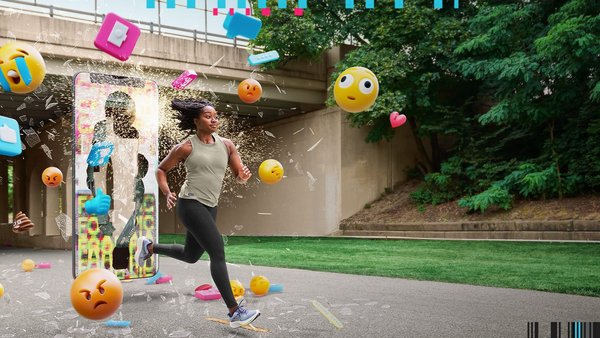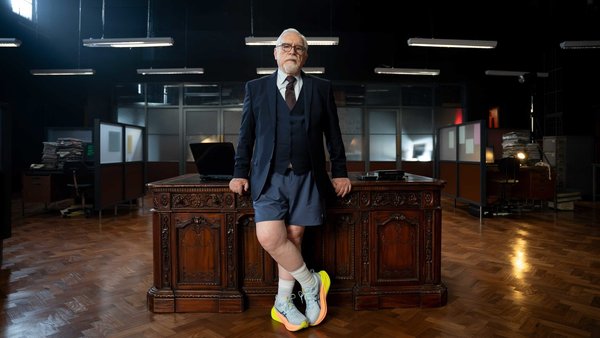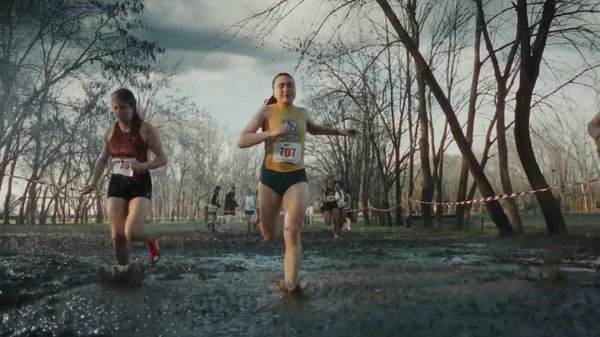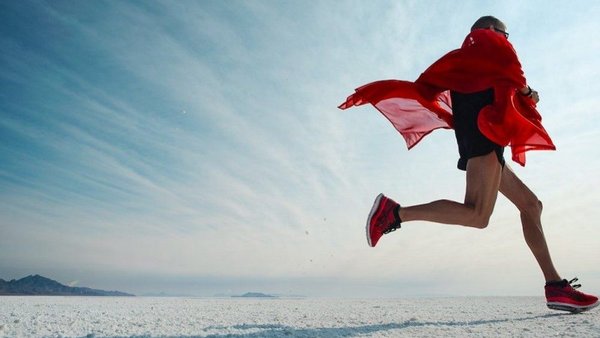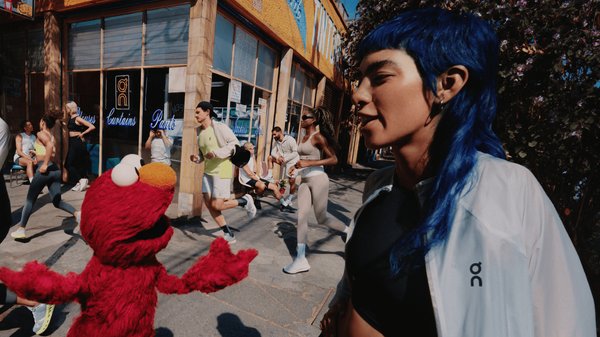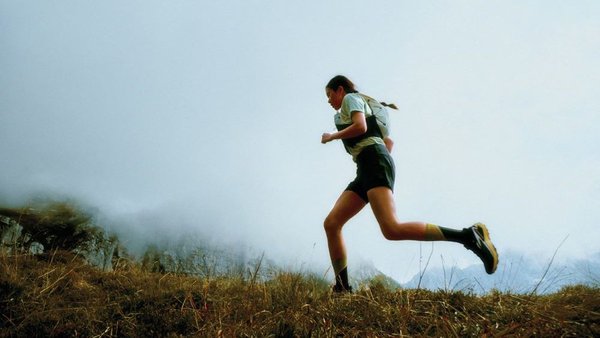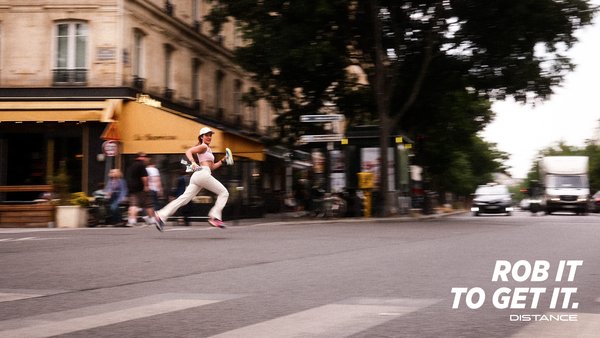In January 2024, Contagious covered Saucony’s The Marathumb Challenge campaign, created in partnership with agency Doner, Detroit. To promote its new Ride 17 Sneakers, the sportswear brand created an app that compares people’s screen time to how much they move every week and rewards those beating their scrolling distance with redeemable merch. The app also tracks participants’ progress, which can be shared on socials tagging Saucony.
The insight behind the initiative emerged from commissioned research by market research company HarrisX which showed that the average person scrolls as much as 78 miles (125km) yearly – equal to three marathons.
The campaign launched the same day as the running shoes, on 22 January 2024, and will last for six weeks.
It is supported by digital, social, ecommerce, retail and OOH promotion across the six markets that make up the US and the UK, Canada, France, Sweden, Italy and Australia.
Results / According to the agency, in the first three days of the campaign, engagement with the social video was 37% higher than the benchmark, there was a 25% increase in new users on the website and a 140% increase in earned media. There was also 19% more traffic on the product landing page compared to the previous week, and a 14% increase in the sell-through rate on saucony.com. Lastly, the retention rate for the app is 50% higher than the average app retention rate.
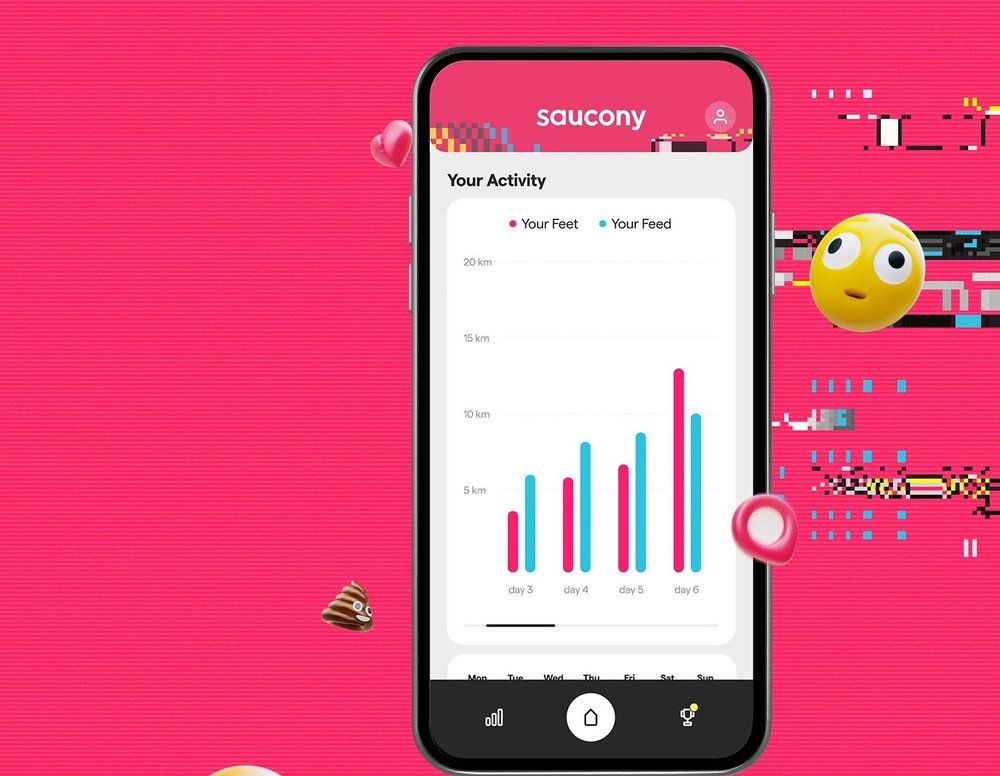
To find out more about the campaign, Contagious spoke to Jordan Yob, senior brand manager at Saucony, and from Doner, Detroit, associate strategy director Alex DeMuth, and group creative director Jeffrey Beck. They told us that:
- As Saucony is a challenger brand that people outside dedicated runners might not know, the brand’s key business objective is building awareness and wider recognition
- The insight behind the idea hung on the tension between people wanting to move more but also being hooked to their phones – leading to the idea to gamify running and making it as addictive as scrolling
- The campaign was targeted at people who aren't necessarily dedicated runners, but who know that exercise is good for them
- Doner attributes the app’s high retention rate to its simplicity of use. The interface, which was designed to be extremely user-friendly, has few buttons and specific functionalities
Tell us about Saucony and how it seeks to position itself in the North American market.
Jordan Yob: Saucony is a 125-year-old brand, it’s been around for a while. This is actually our 126th year, as we started in 1898 out of Pennsylvania. Saucony is rooted in the US and it’s been known to be the original running brand. That’s what we call ourselves. The brand is a leader in global performance running that fuses innovation, style and culture.
We exist to inspire and serve all humans to live a better life. You can see that in a lot of our content and a lot of the people we partner with, we make sure that is true to the brand. Those are some key pieces that differentiate us. We see ourselves as a challenger brand: we’re not the biggest of the big but we're not one of the smaller guys either, we're trying to push ideas that feel out of the box and interesting for our consumer base.
It’s a super competitive, really crowded category. I think a lot of that is driven by the growth of fitness and athleisure, especially coming out of Covid. And it's just continuing to get more competitive.
Jordan Yob, Saucony
As a challenger brand, who are Saucony’s key competitors?
Yob: From a competitive standpoint, we're really focused on more of the athletic, performance footwear brands of the world. It can be any, from all shapes and sizes. These brands that we’re competing against are very similar across the globe
What are the main challenges the category faces? How has the pandemic impacted the sports retail space?
Yob: All of us in the industry have been feeling the exact same kind of impact. Fitness grew substantially during Covid, it was a way for people to get outside. Movement was key for mental health and physical health, and it was one of the only things you could do. As a result, we saw this massive growth. We were at the ultimate high of people buying things like running shoes, hiking shoes, trail shoes, you name it.
During and after the pandemic, we saw a lot of competitors jump in and the landscape became super competitive. And because of that, there’s been challenges.
Now, what's happening is we're starting to see people getting back to the life they lived before Covid. Additionally, we're starting to see consumers be a little bit more cost-conscious in the US. People are decreasing their discretionary spending, which is creating a little bit of contraction. But, in general, we’re still positioned in a great place. We’re just seeing that, after fitness went up so high, we’re now resizing it back to where it was. This means that thinking of creative ideas and new ways to approach what we’re doing is very important.
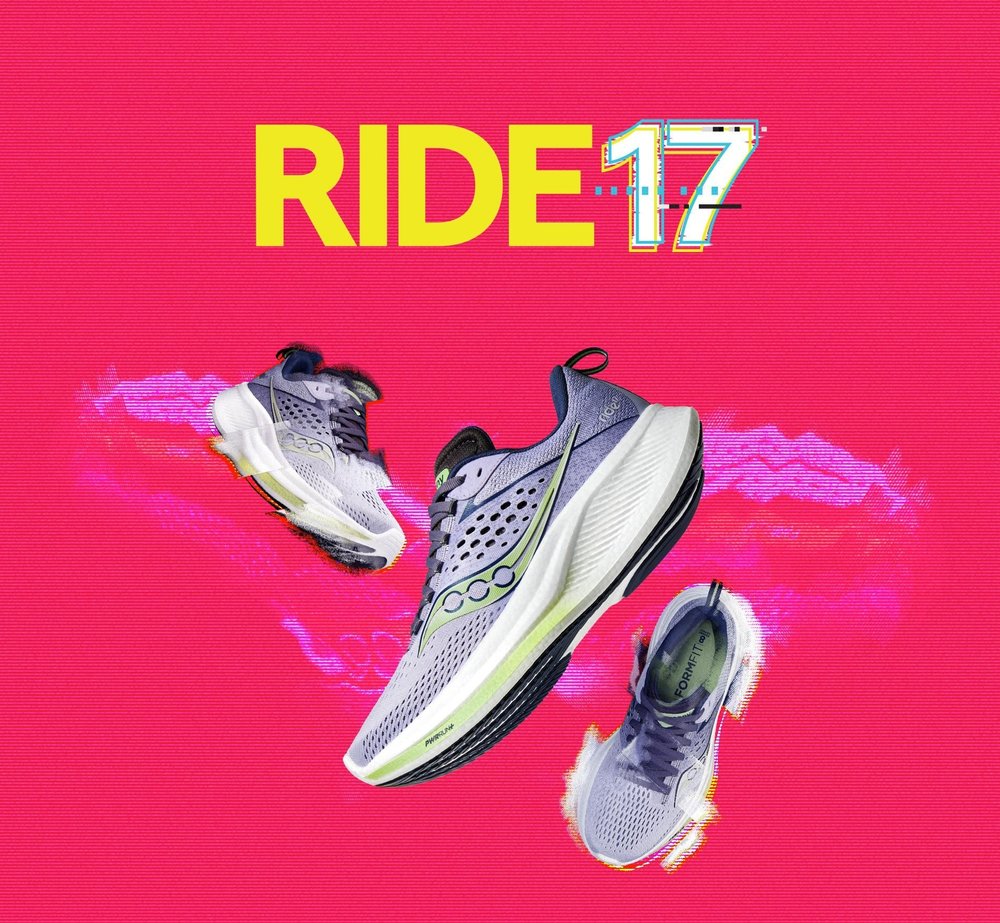
What is the brand’s key business challenge?
Yob: Our key challenge is really around awareness and getting our name out there. We’re not one of the biggest brands out there and a lot of consumers outside of the dedicated runner audience might not know Saucony.
Driving the recognition of the brand and bringing new consumers in is something that we're really challenging ourselves on and I think is a huge challenge heading into 2024.
Alex DeMuth, Doner, Detroit
What was the brief for this campaign?
Alex DeMuth: To help launch the Ride 17 shoe, the updated version of Saucony’s famous Ride series of shoes, and we wanted to do that through a bit of a brand act. [The weekly running challenge] was done in tandem with the launch – what we came up with was more of a brand experience, and the Ride 17 is the payoff to that that enables you to go out and move your feet more than your feed, which worked out nicely.
I think a challenge was that Saucony wasn’t coming out with a new and revolutionary shoe – it was more of a case of evolving the Ride series and trying to make people care about that launch.
The challenges and objectives were to generate brand awareness, but also to connect the brand to new communities of current and potential runners, and to get it into new, different cohorts of people who are already interested in running as well as who might not yet be running.
What was your initial response to the brief?
DeMuth: We were trying to understand cultural truths and consumer tensions, and then figure out what the opportunity for the brand was. This was a case where we saw this truth that people know that life is often a little bit better, or even a lot better, when you’re moving, getting out there, and doing more. And the tension is that we all have phones that are engineered to keep us hooked, and that’s getting in the way of moving more. What we saw there was an opportunity for Saucony to gamify running and really make it as addictive as scrolling already is, to try and get people to run more and scroll less.
New Year’s [...] was a fortunate, good-timing thing. We started working on this about a year ago. It took some time to create an app like this, and it ended up being around the New Year – so we calculated the launch to be around that time.
What was the insight behind the idea for this campaign?
DeMuth: I think this is one of these beautiful occasions where the insight is born from data, but also just from seeing what's happening in your own life and the lives of the people around you: people’s heads are always down their phones. And the data shows that screen time is up all over the world while mental health and exercise time is down. So people are scrolling too much and that’s getting in the way of them moving. That’s where the insight was born from.
Can you tell us about the research you did with the target audience before landing on an idea for the campaign?
DeMuth: There’s plenty of research out there saying that people are scrolling more and more while mental and exercise time is down. But what we did is we went and validated that; we codified the amount of people who are actually scrolling. We did that through research we did with our market research partner HarrisX. We surveyed about 1,000 people to see how much they’re scrolling and understand the dynamics behind the extent to which that’s getting in the way of them moving and exercising. We also tried to understand the state of people’s mental health when they’re scrolling too much.
Who is the target audience for this campaign?
DeMuth: The audience for this campaign is what Saucony characterises as everyday actives, so people who aren't necessarily dedicated runners, but who know that exercise is good for them. The campaign was primarily destined for those people who are in that mindset of, ‘Hey, I should be moving more’. And we think The Marathumb Challenge came as an opportunity to get those people to create better habits.
As to how we’re ensuring to get in front of them, that comes into the launch plan. We worked with influencers to try and get in front of people who might not know that they’re scrolling a little too much and not moving as much as they should. Finding the right influencers and media partners who exemplify that and getting them to join the challenge to get their fans to get in on this was a big part of it.
What does success look like for this campaign
DeMuth: Our effectiveness metrics were really earned media and engagement. A third layer to that was, of course, generating more interest in the brand and selling the Ride 17 shoes, getting people to go to the webpage and show that interest. But it all started with that idea of earned media, trying to generate more awareness and getting Saucony in front of a new type of consumer.
Jeffrey Beck, Doner, Chicago
How important was the app in the campaign? Was gathering consumer data a part of the strategy?
Yob: Originally, when we created the app, there really wasn't a goal to collect any data. It was honestly just the vehicle to drive excitement and buzz around the campaign. We heard the insight from a brand standpoint that consumers are scrolling three marathons a year, and I think we were all seriously mind-blown and wanted to do something to get consumers to start moving, and the app was a vehicle to do that. Its real goal was highlighting the insight, getting people to connect with the brand, know about the brand and then potentially buy the Ride 17 sneakers.
However, as it started to evolve, we began to realise that data could be a piece of it, as we can understand how much our consumers are stepping. We thought about it more from a consumer journey standpoint, versus a data standpoint. We wondered: how are we getting the consumers to download and start to engage with the app, then push them to our website and have the experience and data live there? So, I don’t want to say that gathering consumer data was an afterthought, but it wasn’t at the forefront of why we created the app itself.
[In terms of results], we were just looking at the retention rate this past weekend. We saw how we are doing in terms of keeping consumers engaged in the app, and we’re up 50% versus the average app retention rate, which is really cool to see.
Jordan Yob, Saucony
Jeffrey Beck: If you download the app, you can see that there are not a lot of buttons, it’s not very complicated. It’s a simple three or four-step click experience. And that was incredibly intentional, to be able to get a quick view of how your feet are stacking up against the feed and to gamify it in a way that’s super easy to understand. If we would have made this thing very complicated, I don't think we would have seen some of the numbers that we're seeing now in terms of retention rate. And that was by design, it is quite a simple, fun experience to engage with.
What was the media plan?
Yob: The plan itself was extremely integrated. It honestly touched every single consumer. We’re pushing influencers, we made sure we had paid [content] to then resend the message [around the Ride 17 Sneakers]. The other thing is that it was global. We were across six different countries around the world, and the plan changed depending on the country and the consumer base, but it was really thought out and ultimately pushed to drive momentum across the challenge in the first month. Then we'll pivot to push the Ride 17 after that.
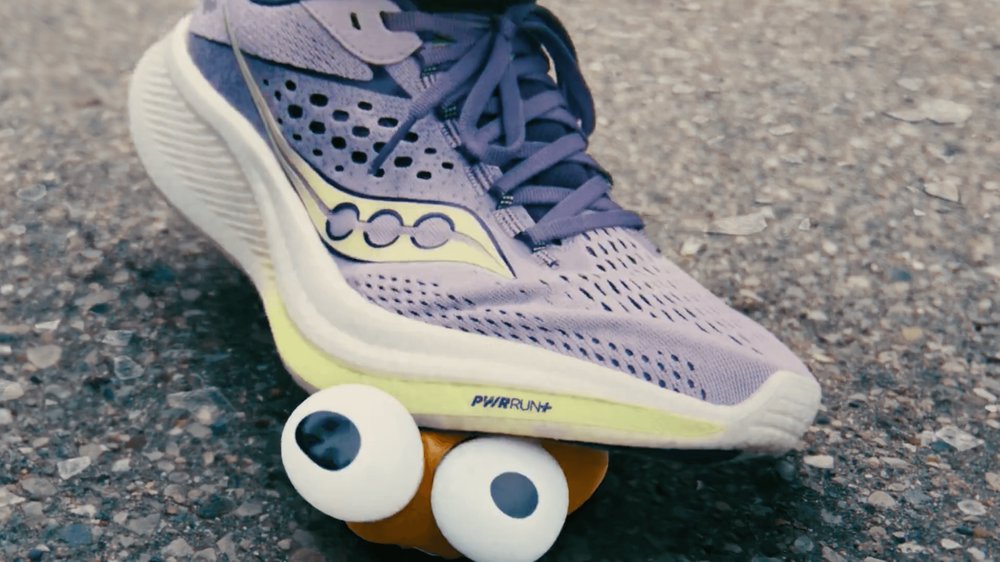
What challenges did you face during the process of bringing this campaign to life?
Beck: We did start this journey about a year ago, so it’s been a little bit of time that we’ve spent working on this thing. I think making an app can be difficult, just creating it does come with certain challenges.
We were working through some things related to how it launches in different countries and coming up against a few barriers with some of the different operating systems and how they intake apps into their store. That was a bit of a challenge, but at the end of the day, and I know this is going to sound a little cliché, we all held hands and made this thing happen together because we really believed in it. With any challenge, we had a plan A, plan B, plan C, and plan D to help things get across the finish line.
What has been your single greatest learning from this campaign?
DeMuth: It’s linked to the challenges, but it’s how much time, energy, and focus goes into making even a simple phone application. There’s that, but also how simple it is to get people exercising a little bit more. All you need is a little bit of a utility on your phone, a feedback loop and a reward system to help people move more. For me, that has been really meaningful.
Beck: For me, I think it was how addicted we all are to our phones, more than we may realise, and how much we all want to break that cycle. And the campaign was our instrument to allow you to do that. I think it is crazy. We have these things in our pockets that are designed to keep us there forever. When we started doing this and seeing some comments and engagement with the app, [we understood] people really appreciated something that allowed them to break free of that.
Yob: Mine is more from a brand marketing standpoint. Sometimes, you just have to take a little bit of a risk in order for something to stick. When Doner came to us with this insight and this idea, it was a little risky from a brand standpoint, but we felt like we had to do it. It was rooted in such a strong consumer insight, and Saucony is a very consumer-obsessed business. So, in our team, we were all ready to go, we thought ‘we have to do this’. It was such a cool initiative that we took a risk on it, and I think it really paid off. Sometimes it just takes a risk.
